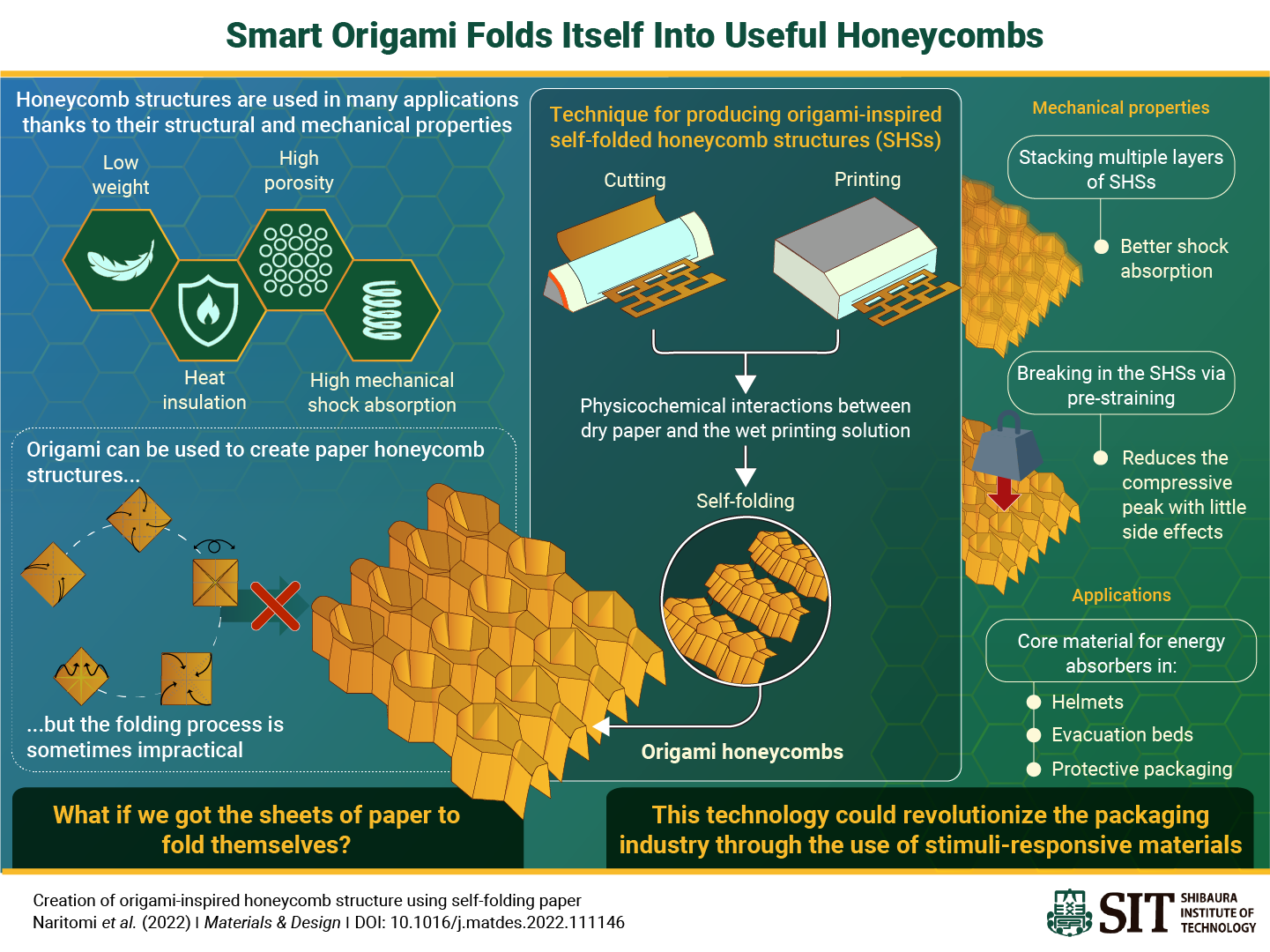Reviewed by Emily Henderson, B.Sc.Nov 2 2022
Honeycomb structures are extensively utilized in materials engineering due to their attractive structural and mechanical characteristics, like low weight and high porosity. Japanese researchers established a method to create self-folding origami honeycomb structures with the use of just a cutter, paper, and an inkjet printer in a recent study.
 In a recently published study, researchers from SIT, Japan, developed a cost-effective method of making paper sheets that fold themselves without any human intervention into honeycomb structures with superb structural and mechanical properties. Image Credit: Hiroki Shigemune from SIT, Japan
In a recently published study, researchers from SIT, Japan, developed a cost-effective method of making paper sheets that fold themselves without any human intervention into honeycomb structures with superb structural and mechanical properties. Image Credit: Hiroki Shigemune from SIT, Japan
Particularly, this cheap technology is promising for custom-made protective packaging for delicate goods, which include vegetables or electronic components, as well as protective gear, like helmets.
Origami is the act of folding flat sheets of material into complicated 3D shapes. It has come a long way from its authentic ceremonial and artistic roots to the engineering realm. Owing to their cheap cost and easy fabrication process, origami-based materials and structures have found usage in different industries, which include packaging, biomedicine, agriculture, and spacecraft.
Finding a suitable, profitable method to fold the sheets of material into the expected shape is one of the most challenging features of employing origami for practical uses. The folding procedure can be specifically difficult for origami structures of both very tiny and very huge sizes. Consequently, researchers have been keenly attempting to bring new methods to make self-folding origami structures that are compatible with their target application.
In a new research, a study group from Shibaura Institute of Technology (SIT), Japan, established a promising method to build self-folding origami honeycomb structures (SHSs) easily.
As described in their paper published in Materials & Design, honeycomb structures can be good protective packaging materials thanks to their several attractive features that include high porosity, low weight, excellent mechanical shock absorption, and heat insulation.
Encouraged by this, the team created a cheaper process to make SHSs with the use of just a standard inkjet printer and a paper cutter. The research was headed by Associate Professor Hiroki Shigemune and co-authored by Professor Naoki Hosoya and master’s student Daichi Naritomi, all from SIT, as well as Professor Shingo Maeda from the Tokyo Institute of Technology.
The study is available online from September 16th, 2022, and it will be published in Volume 223 in November 2022.
The significance of this new method to create SHSs is to get benefitted from the physicochemical interactions that happen between the printed solution and the paper. Firstly, the scientists cut out a grid of rectangles on a flat paper sheet, and secondly, they used the inkjet printer to implement the printing solution in a meticulously devised pattern. This led to the self-folding of honeycomb structures in just a few minutes.
The researchers concentrated on examining how several parameters of the printing and cutting patterns impacted the mechanical and structural properties of the final product. Upon identifying a set of ideal parameters, they verified two extra ways to further enhance the SHSs’ mechanical performance.
The first was piling several honeycomb layers one over the other, which largely improved the cushioning performance of the final structure with slight changes to its height. The second was the honeycomb structure’s pre-straining, which is basically putting on a strong compressive force before employing the material.
By “breaking in” the material in this method, they avoid a compressive force peak that happens for the first time a brand-new SHSs is compressed, which can damage the protected object.
The suggested method to produce SHSs can find use across a wide range of applications, as Associate Professor Shigemune describes through a few examples.
Our technique could be used to create tailor-made cushioning materials at farm sites based on the type and harvesting period of fruits and vegetables. Alternatively, it could be used to produce evacuation equipment, such as helmets and beds, using SHSs as a core material.
Shigemune, Associate Professor, Shibaura Institute of Technology
One more noteworthy benefit of SHSs is that they are composed purely out of paper, a material that consumes little storage space, and that can be processed rapidly at a cheap cost. It is also notable that SHSs must be regarded as green technology as they are built from nontoxic materials utilizing very little energy.
Our technology contributes to sustainable development goals because it allows us to protect fragile components and vegetables, which translates to fewer losses.
Shigemune, Associate Professor, Shibaura Institute of Technology
Be ensured to look forward to more self-folding origami-based materials and their advanced applications!
Journal Reference:
Naritomi, D., et al. (2022) Creation of origami-inspired honeycomb structure using self-folding paper. Materials & Design. doi.org/10.1016/j.matdes.2022.111146.